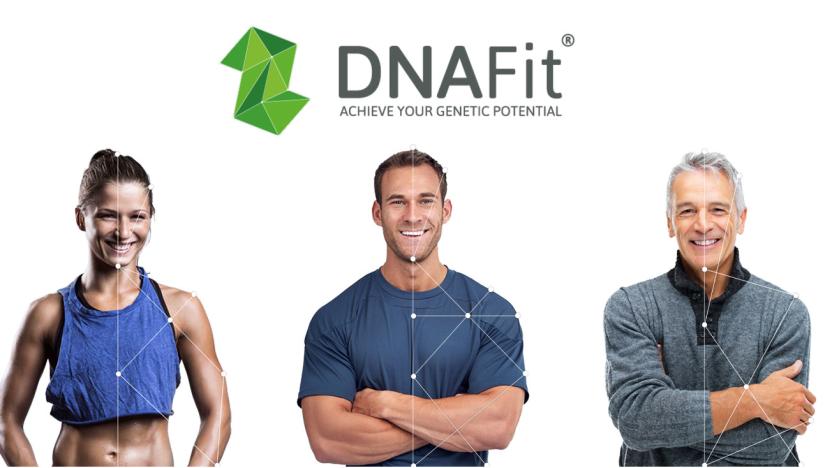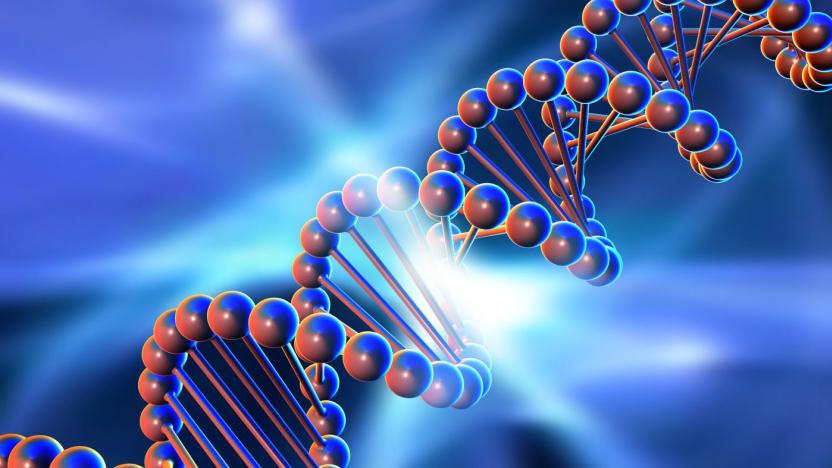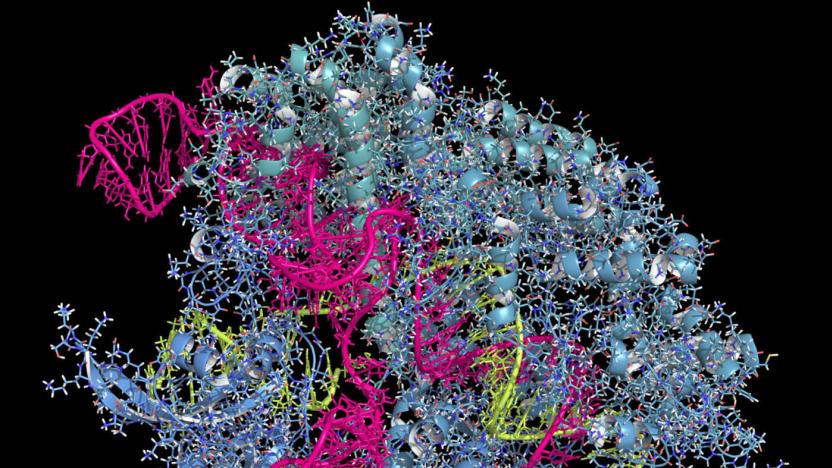DNA
Latest

Microsoft wrote an OK Go music video to DNA
OK Go's song "This Too Shall Pass" is merely a serviceable song with an interesting video that features contraptions inspired by Rube Goldberg. Microsoft and the University of Washington have deemed it important enough to write it to the largest DNA storage trove created to date.

Gene editing can end disease and fight global famine
We're looking at the single greatest advancement in genetics since Mendelev started growing peas. CRISPR-Cas9 gene-modification technology is powerful enough to cure humanity's worst diseases, yet simple enough to be used by amateur biologists. You thought 3-D printers and the maker movement were going to change the world? Get ready for a new kind of tinkerer -- one that wields gene-snipping scissors.

Genes, germs and bacon: A look inside my own DNA
There are times in your life when bad news smashes into your gut like a sledgehammer into the solar plexus. "You've got those double dots next to your CYP1A2*F, which means that we class you as a fast metabolizer." But the man on the other end of the phone was not complimenting me. Rather, he was explaining that my body can't cope with the chemicals produced by smoked or chargrilled meat. It meant that, despite my love of meat, I would have to limit myself to "just one or two servings of grilled or smoked meat per week," and even that was excessive. The news got worse when I was told that, for a similar reason, I should also avoid fried bacon -- which I eat every morning to pep up my protein-and-fat rich breakfast of eggs. My genetic makeup, the bastard, has rendered me incapable of enjoying bacon, which is a hard way to be introduced into the world of DNA fitness testing.

Science fund lets kids learn 3D printing, gene modification
President Obama declared June 17 to the 23rd to be the National Week of Making, and what better way to celebrate than funding research for kids? The National Science Foundation (NSF) created a $1.5 million "early-concept grant" for five youth-oriented projects. They include 3D printing for inner-city kids and a DNA project that teaches high schoolers to build their own organisms (yep). "A core tenet of the maker movement is that experiences involving active exploration of ideas ... elicit enjoyment and foster lasting learning," says Rutgers' Elizabeth Bonawitz.

The After Math: Can't buy me love
There's something in the air this week. Seems everybody's in L-O-V-E, love. Well, except maybe this guy. Researchers successfully tested a new gene therapy using the DNA from three donors. Lenovo debuted the world's first Tango-enabled smartphone. Tinder kicked all the kids out and Google's gave its devs something to crow about. Numbers, because how else would we know that one is the loneliest?

Scientists want to perfect humanity with synthetic DNA
Following a controversial top-secret meeting last month, a group of scientists have announced that they're working on synthesizing human genes from scratch. The project, currently titled HGP-Write, has the stated aim of reducing the cost of gene synthesis to "address a number of human health challenges." As the group explains, that includes growing replacement organs, engineering cancer resistance and building new vaccinations using human cells. But in order for all of that to happen, the scientists may have to also work on developing a blueprint for what a perfect human would look like.

New algorithm performs complex DNA origami
Researchers from MIT, Arizona State University and Baylor University have developed a new algorithm that promises to simplify the arduous and complex task of assembling DNA into structures other than a double helix. These structures could eventually be used as everything from DNA storage modules to delivery vehicles for CRISPR enzymes and other medicines, but until now the process of creating them has been prohibitive.

Researchers create mirror image of DNA-copying protein
Scientists at Tsinghua University in Beijing have created a mirror-image version of a protein responsible for two life-critical functions:, copying DNA and transcribing it into RNA. This is a crucial step in someday making reverse-versions of molecules that could be more resistant to viral attacks.

Scientists held a secret meeting to debate creating synthetic human genes
On Tuesday, about 150 scientists, lawyers and entrepreneurs gathered at Harvard Medical School to discuss a future project to improve techniques to synthesize human DNA from chemicals. But they held the meeting behind closed doors, with explicit instructions not to contact the media, getting the scientific community in a tizzy. At the top of their worry pile is that the project will end up innovating new ways to make synthetic human genes, which could lead to them being used to artificially create humans.

Microsoft is using synthetic DNA to store data
Microsoft's data might be intact for thousands of years to come, now that it's looking into DNA storage as an option. The company has purchased 10-million-long oligonucleotides (DNA or RNA molecules) from San Francisco startup Twist Bioscience. According to IEEE, Redmond converted a chunk of data into DNA nucleotides -- G's, A's, C's and T's -- and had Twist make 10 million synthetic DNA strands with the sequences it specified. The startup doesn't actually have access to the data, since it doesn't have the key, and the only way to decode it is through DNA sequencing.

Gene editing discovery might treat many more diseases
In theory, gene editing could eliminate genetic diseases by correcting the flaws in your DNA. However, there's one big obstacle: the current CRISPR technique has trouble modifying individual DNA letters. As most genetic conditions revolve around mutations of those single letters, that leaves most conditions untreatable. However, Harvard researchers might have just made a breakthrough that turns gene editing into a true disease-ending weapon.

Researchers made the smallest diode using a DNA molecule
A team of researchers from the University of Georgia and Ben-Gurion University has developed an electronic component so tiny, you can't even see it under an ordinary microscope. See, the team used a single DNA molecule to create a diode, a component that conducts electricity mostly in one direction. Further, the DNA molecule they designed for the study only has 11 base pairs. That makes it a pretty short helix, considering a human genome has approximately 3 billion pairs.

Programming language makes circuits out of bacteria
Biological circuits have been a reality for years. However, making them is no mean feat: you typically have to create everything from scratch, which is impractical for everyone but a specialized genetic engineer. MIT has a better way, though. It developed a programming language that makes it comparatively easy to produce these organic machines -- you just write code (based on existing computer instructions) and get a bacteria-friendly DNA sequence that does what you want. In the lab, sample circuits in E. coli did everything from ranking inputs to measuring oxygen levels.

ICYMI: Portable DNA lab, drone inspired by bug and more
#fivemin-widget-blogsmith-image-420543{display:none;} .cke_show_borders #fivemin-widget-blogsmith-image-420543, #postcontentcontainer #fivemin-widget-blogsmith-image-420543{width:570px;display:block;} try{document.getElementById("fivemin-widget-blogsmith-image-420543").style.display="none";}catch(e){}Today on In Case You Missed It: Bento Lab is releasing a portable lab to analyze DNA, the Picobug drone can autonomously switch from flying to crawling and back again, and NASA is giving the people what they want, since what they want is a HoloLens tour of what Mars is really like. We're also summing up the week for you in our TLDR segment. While we didn't include it because the news keeps changing, please do read up on the Japanese satellite that may or may not have splintered into five different pieces, but then sent some communications. Very X-Files. As always, please share any great tech or science videos you find by using the #ICYMI hashtag on Twitter for @mskerryd.

Human-made bacteria has the tiniest genome ever
Believe it or not, creating artificial life (albeit based on existing species) isn't new. However, scientists have managed a particularly unusual feat: they've built synthetic bacteria that has the smallest known genome of any lifeform... ever. Their modification of Mycoplasma mycoides has just 473 genes, or so few that it likely couldn't survive and reproduce if you shrank the genome further. The trick was to do a better job of determining which genes were essential. Many of those that weren't deemed necessary in the past turned out to be half of a vital pair, giving researchers a good sense of what they could afford to cut.

Gene test spots all known inherited heart conditions
You might never have to worry that you'll fall victim to a heart condition passed along by your family. Researchers have developed a blood test that can reliably detect all known inherited heart problems, like genetically-based arrhythmia -- if doctors know about it, they can spot it. Previous tests only looked at a handful of genes and were only useful in certain circumstances, but the new technique identifies flaws in all 174 genes linked to the potentially life-threatening issues.

Scientists decode the bedbug's genes to help kill it
Just the very thought of bedbugs probably makes your skin crawl, and that's made all the worse by their ability to adapt to new threats. Like it or not, that pesticide you used years ago probably doesn't work any more. What to do? Genetics might just come to the rescue. Scientists have created the first full genome sequence for the bedbug in hopes of defeating its resistance to sprays and other attempts at extermination. You'd think this would have been easy (humans can sequence woolly mammoths, for goodness' sake), but it wasn't -- the team had to compare bedbug genes from 1973 with present-day samples, and even the differences before and after the bugs had their blood meals.

US medical panel recommends 3-person embyronic testing
The US National Academy of Medicine recommended Wednesday that the Federal Drug Administration should approve clinical trials for so-called "3-parent embryos." It's a controversial procedure that would transfer mitochondria from a healthy, secondary human egg donor into a fertilized diseased embryo.

23andMe says being a morning person is in your genes
Are you the sort of person who wakes up with the Sun? You might not just have a go-getter attitude to thank for it. The genetics firm 23andMe has published a study which suggests that variances in 15 regions of the human genome (including seven that influence circadian rhythms) affect the likelihood that you're a morning person. No one area instantly flicks the switch, but it adds up -- the more your genes skew a certain way, the more likely you are to think that 6AM is a perfectly reasonable time to hop out of bed.

UK scientists get permission to 'gene edit' human embryos
A team of British scientists has been approved to use "gene editing" techniques on human embryos, in the hope that it will better our understanding of early human life. A group at the Francis Crick Institute in London wants to research newly fertilised eggs and how they develop in the first seven days -- from a single cell to a blastocyst with roughly 250 cells. Using gene manipulation, the researchers want to glean new insights about our DNA and the exact requirements for a healthy embryo. With this information, specialists could find ways to improve post-IVF embryo development techniques and clinical treatments for infertility.








